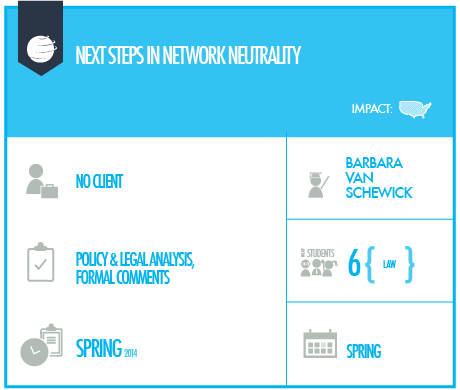Next Steps in Network Neutrality
Overview

Earlier this year, the Court of Appeals for the D.C. Circuit struck down the Federal Communications Commission’s Open Internet rules forcing policy makers to assess a range of challenges and options. This shift in thinking and policy must respond to new limitations around the Federal Communications Commission (FCC) Open Internet Order of 2010, which enacted binding network neutrality rules for the first time. Network neutrality rules limit the ability of Internet service providers to interfere with the applications, content and services on their networks; they allow users to decide how they want to use the Internet without interference from Internet service providers.
In countering the core provisions of the Open Internet Order, the Court of Appeals for the D.C. Circuit stuck down the rules against blocking and discrimination. The decision combined two wins for the FCC with one decisive loss. According to the Court, the FCC has authority to regulate providers of broadband Internet access service under Section 706 of the Telecommunications Act of 1996, and the FCC’s justification for the Open Internet Order is “reasonable and supported by substantial evidence.” The no-blocking and non-discrimination rules, the Court found, however, violate the Communications Act’s ban on imposing common carrier obligations on entities like Internet service providers that the FCC has not classified as telecommunications service providers under Title II of the Communications Act. As a result of this ruling, Internet service providers like Verizon, AT&T or Cox Cable that connect users to the Internet are now free to block any content, service or application they want. They can slow down selected applications, speed up others, or ask application or content providers like Netflix or Spotify to pay fees to reach their users. These practices will fundamentally change how users experience the Internet.
The court’s decision has led policy makers, stakeholders and observers to a vibrant debate on how best to ensure that the Internet remains open and free. Policy makers essentially have three options: First, the FCC can preserve the Open Internet Rules by reclassifying Internet service as a telecommunications service under Title II of the Communications Act. Second, it can develop a different, narrower network neutrality regime under Section 706 of the Telecommunications Act within the boundaries established by the Court of Appeal’s decision. Finally, Congress or the FCC can adopt a new network neutrality regime, but only, in the case of the FCC, after reclassifying Internet service as a telecommunications service.
In mid-February, 2014, the Federal Communications Commission opened a docket within which to consider how the Commission should proceed. Students researched options and helped to write policy reports and comments that will help the Commission develop the next generation of Internet rules and regulations.
Faculty
Clients & Deliverables
Deliverables:
- Legal and Policy Research contributing to public testimony by Barbara Van Schewick before the Federal Communications Commission “Open Internet Roundtable: Tailoring Policy to Harms” (9/14/14)
This Practicum assessed options to help develop next generation policy in the wake of a court decision striking down core provisions of the Federal Communications Commission’s Open Internet Order of 2010.

